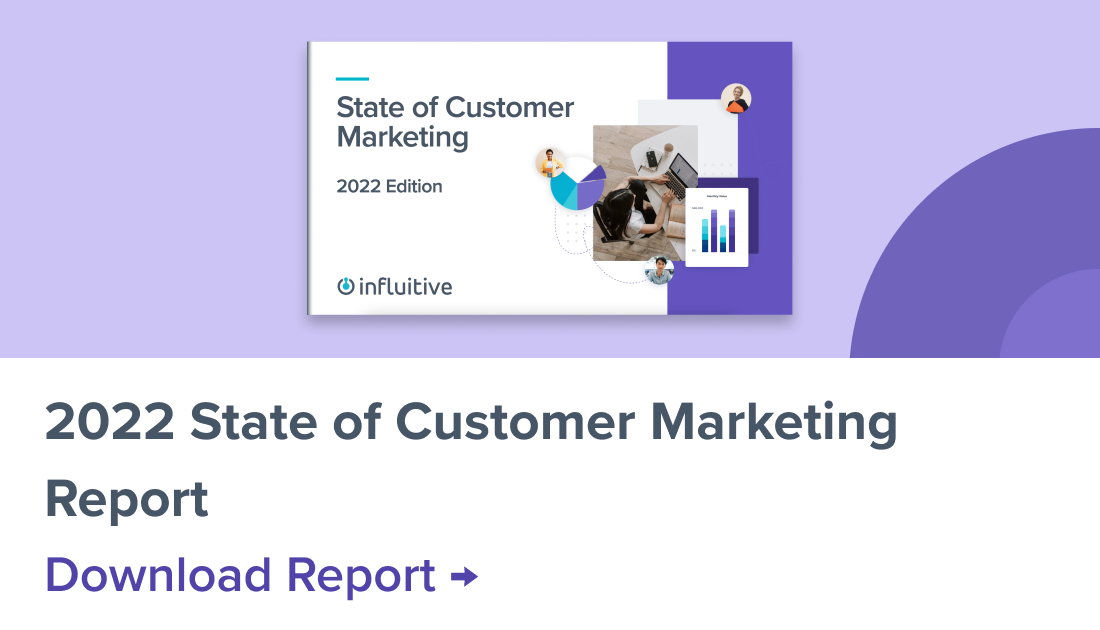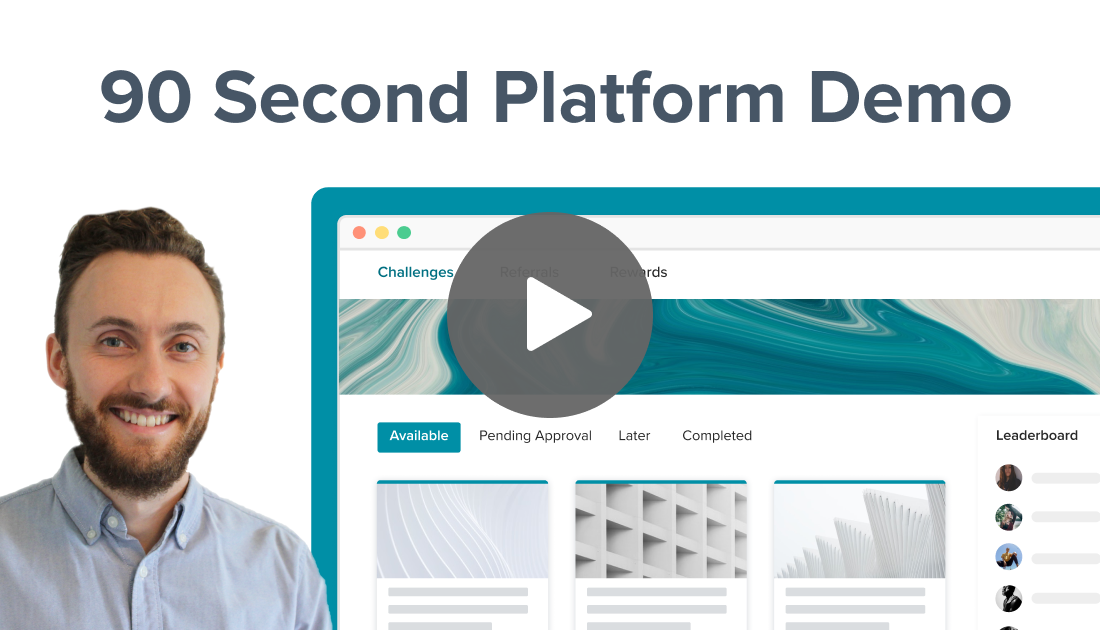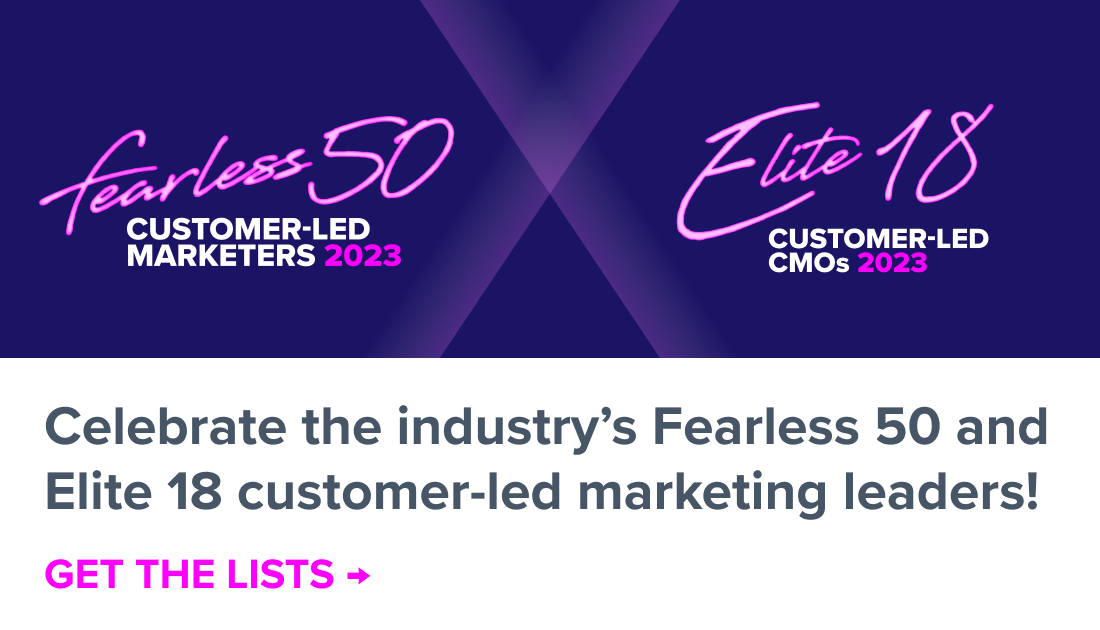I’m going to let you in on a little secret that sets apart the most successful advocate marketers from the rest.
Instead of just posting a few ad hoc challenges per week in their programs, they use campaigns to drive long-term engagement and results.
What do I mean by campaigns in the context of your AdvocateHub advocate marketing program? A campaign is a coordinated series of challenges with a theme or focus that is designed to achieve one or more core success metrics. And campaigns are driving advocate marketing leaders to become more strategic and successful than ever before.
The Influitive Client Services team has spent hours building a variety of campaigns our customers can use in their advocate marketing and customer engagement programs on our AdvocateHub platform.
Today, I’m sharing what we’ve learned about creating engaging campaigns that get results.
We’ve identified seven components that are important to planning and executing a successful advocate marketing campaign. If you don’t have an AdvocateHub program, you can still use this framework to build your own customer engagement campaigns.
Building block #1: Metrics and measurement
Metrics and measurement are the most important thing that you need to figure out before you begin building a campaign. What do you want to achieve, and how will you determine that target?
It can’t be something that’s general like, “I want more engagement,” or “I want to make my advocates happy.” It needs to be quantifiable.
We’re often asked, “Can I do multiple objectives within one campaign?” And the answer is yes. We often build our campaigns to have a primary and a secondary objective. However, you must prioritize one objective and optimize for that one. If you are trying to go after two separate metrics in equal measure, it can be confusing for your advocate, and divert attention—meaning you may not reach your core target.
Here are three rules of thumb for making this easier:
- Record the start and end dates for your campaign. This way, when you go into your reporting tab inside your AdvocateHub, you can correctly filter and see the impact that the campaign had. This will not only show the direct results from the campaign, but also how the campaign affected engagement within your overall program.
- Always collect feedback from your advocates. When we build campaigns, we include a challenge that asks advocates to give their feedback on how they enjoyed the experience. This is how you will keep refining your campaign’s strategy. You can ask them about the theme, challenges, timing, or rewards.
- Share the results of your campaign internally. Package your results in a format that’s digestible for your internal teams to easily highlight the impact your campaigns are having.
Here’s an example of an internal announcement or report for a campaign you can share internally. I suggest for you to create a template of your own to use after you run a campaign.
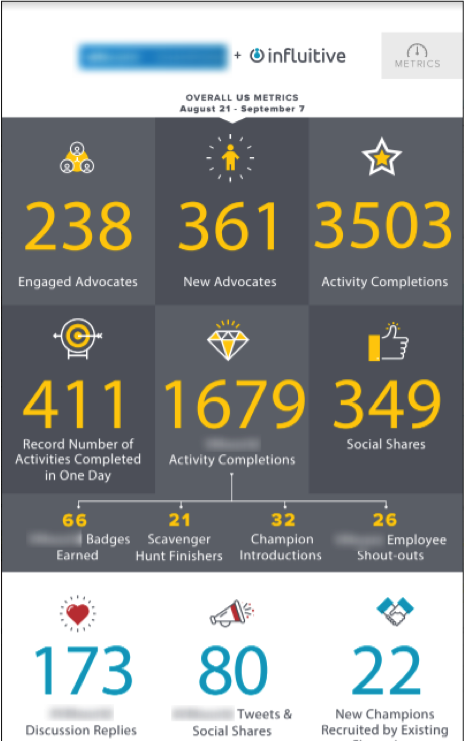
Building block #2: Knowledge of your audience
It’s important to understand who you are designing your campaign for. It will make a huge difference in how you go about building the theming, the gameplay, the storyline, even your core metric that you’re trying to hit.
For example, my peer Deena Zenyk, had a program where her advocates were educators. They weren’t very competitive. They were more influenced by wanting to do good together. They liked friending and networking.
On the other hand, I used to run a program that was geared toward an IT audience. That audience was extremely competitive. They were very into accomplishments, points, badges, and rewards. It is important to determine from the outset what your particular audience is motivated by. The less generic, the more engaging your campaign will be.
You can define your audience by a combination of things, like:
- Job role
- Industry
- Longevity within the program
- Level of experience with your products
- Personality type
- Age
- Gender
- Location
Here’s the types of drivers that may inspire your audiences:
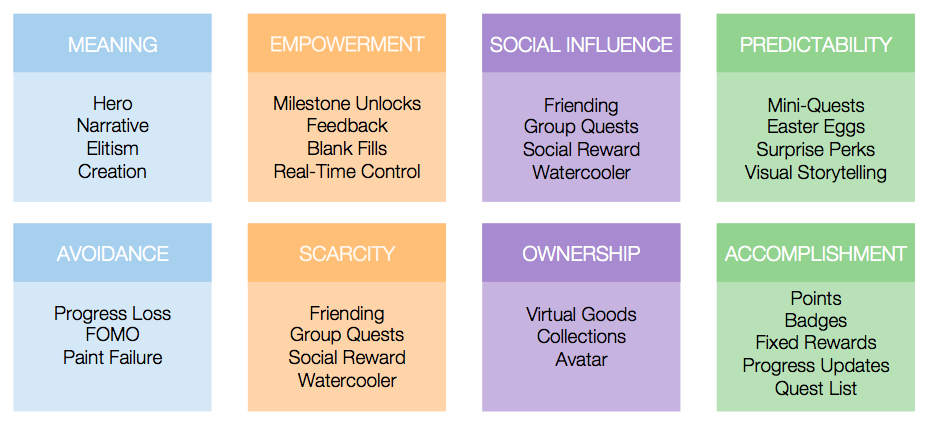
Once you’ve defined the audience, you can use our Experience feature to target a group of challenges to a specific segment of your program. Experiences are essentially mini-AdvocateHubs where all the challenges are grouped separately for a specific campaign or event.
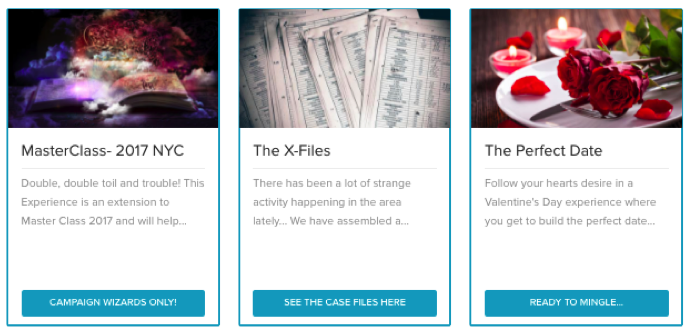
This is a wonderful way to run campaigns in your AdvocateHub because it keeps things very clean for you as an administrator and for your advocates. It makes targeting much easier as well. Only advocates who have the ability to participate in that Experience will see those set of challenges.
You can still build campaigns in your AdvocateHub without Experiences. You would just target campaign challenges to a specified group, but you’ll have to set this up individually within each challenge.
Building block #3: Budget and resources
How much should you invest in any given campaign? The way to determine this is to ask yourself, how much is achieving your primary metric worth to you? You’ll want to invest more in high value campaign drivers (referrals) and less for more simple tasks (social shares) that may not be quite as valuable.
Your cost analysis should include:
- Special incentives and rewards for the campaign that may or may not fall within your overall program budget. Some advocate marketers calculate this by looking at point values they predict they will give out for challenge completions, and then translate this to reward costs.
- Potential marketing costs. Some people get creative and invest funds to get people into the campaign. At my last company, I spent a little bit on Facebook ads and targeted them to our Facebook followers to remind them to come in and recruit new players as well because I knew they were going to be on Facebook every day.
You also need to think through the time investment of building your campaign.
A couple quick tips for resourcing:
1. Think about intrinsic rewards. You need to focus heavily not just on extrinsic rewards, like gift cards and that sweepstakes prize, but also what’s in it for your advocates emotionally and internally. If there’s a deeper reason for participating in or doing something they’ll be more likely to participate. What emotional needs can you fulfil with your campaign? Intrinsic motivators are things like professional growth and helping others.
2. If you have a tight budget, consider low or no point value challenges. If there are strong intrinsic motivators that will drive participation (mentioned in #1 above), advocates might still be eager to participate in your campaign, even if you’re awarding lower point values for challenge completions.
3. Start negotiating with people internally at your company to uncover more rewards. If you’re struggling to find rewards for campaigns within your own budget, think about who else in your company is benefiting from your advocate program. Ask your Events team for leftover event swag, or partner with Product and ask them to give a one-on-one sneak peek of an upcoming feature to the campaign winner.
4. If you have time constraints, automate as much as possible. Consider building challenges that don’t require administrative approval so advocates aren’t waiting for you to review their responses.
Building block #4: Strategic campaign timing
It’s important to give your campaign a time limit to create urgency and clarity. This allows users to understand how long they have to complete challenges, which helps them determine how to invest their efforts.
Calendarizing your campaigns also helps you budget time and resources, and gives structure to your customer engagement planning. As you think through your core metrics that you need to hit throughout the year, planning distinct campaigns for each month will allow you to figure out exactly when you are going to invest in hitting those specific metrics and in what timeframe you hope to hit those targets.
Another aspect of campaign timing is challenge cadence. There are three main timing options that we use for our campaigns: instant, drip and unlock.
1. Instant timing. When an advocate comes in, they see all the challenges within the campaign, and choose any challenge they want to play at any time.
The main pro with this type of approach is that there’s no risk of loss of excitement. An advocate can do as much of the campaign as they want, which can create quick results for you.
A major downside of this approach is that the storyline can be less engaging. Since you have to build each of these challenges to be generic enough to complete in any order, this limits the sense of urgency and motivation.
Our Around The World Campaign has all challenges published at once.

2. Drip timing. In a drip campaign, new challenges become available each day.
If you are keen on your advocates signing into your program more often, this is a fun timing choice to try as it creates anticipation. If you have resourcing limitations, this option can help you control how much administration is needed per day.
A negative is that you will have the possibility of seeing campaign abandonment as people lose steam, or have a shift in priorities.
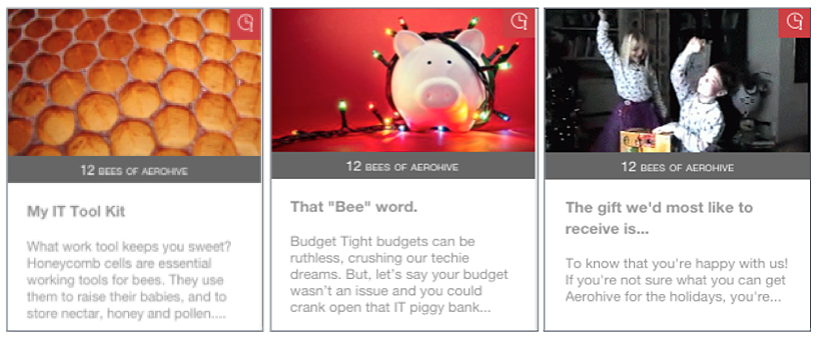
3. Unlock timing. The reason I like unlocking so much is because it really focuses on storyline.
This is an example of a Haunted House Campaign where you go into a house, you’re trapped inside and then you have to pick different doors. As you open different doors, it unlocks different rooms and there’s a set of challenges for each of those rooms.
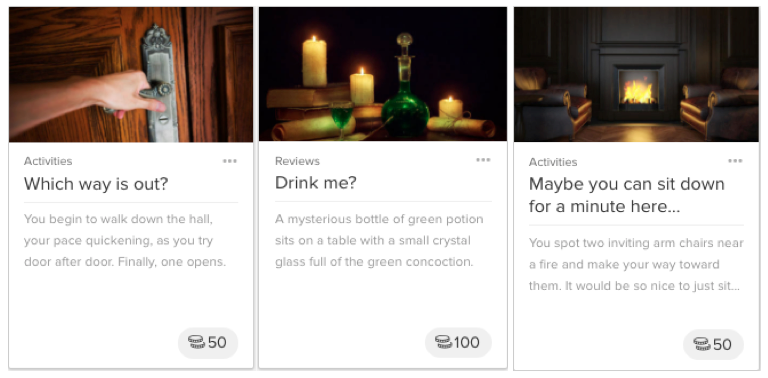
The unlocking technique drives engagement through unpredictability.
One con is that it can definitely be a little bit more complicated to build. You have to know that they have to do X in the story before they’re going to get to Y, so you can be a little bit more elaborate with the theming and story that you’re creating, and the setup of the challenges.
It can also create blockers for reluctant players. Let’s say they get to a part of the campaign and they just really don’t like what you’re asking them to do. You could see people drop off there because they don’t want to continue. Start with low barrier asks and move to more complicated ones to avoid massive drop offs early on.
Ultimately, there is no right or wrong timing option, and we often combine different timing options to create a single campaign. What’s important is to clarify what approach is going to be the most engaging for your audience.
Q. “How long should a campaign run for?”
A. We usually advise standard campaigns run for one to two weeks, and quick campaigns for anywhere from a day to a week.
Quick campaigns can create a lot of excitement and you get a lot of results very quickly. The risk with short campaigns is part of your audience may not be able to participate due to their schedules (vacation, conferences, etc.). So, you risk excluding people if you go this route.
Building block # 5: Theme
Theming is important because at the end of the day, games are just a set of rules. But theming is what makes rules palatable. It enhances gamification stickiness, and it is the fun and creative soul of your campaign. A good theme is what will make your campaign an exciting and memorable experience.
A theme also can create cohesion between multiple campaign objectives. If you have more than one objective you’re trying to drive for in a campaign, they might be quite different, but with a theme you can bring those objectives together and put a wrapper around it so it doesn’t seem so jarring or unusual to the advocate.
The themable elements within your campaigns are the storyline and the gameplay. You can also consider changing the design within your main AdvocateHub for the time of the campaign to direct more attention to the campaign.
You’ll want to make sure your incentives also fit within the theme. Let’s say your theme was “Around the World.” You could just offer an Amazon gift card, but a much better idea would be to get a brand new set of travel luggage for the winner.
When you’re brainstorming themes is, it’s useful to poll your program members. To find out what resonates with them, set up a challenge that asks them questions about:
- What are the pop culture things that they are interested in?
- What sports is your audience most interested in?
- What do they like doing in their spare time?
If you don’t have this info, you can choose a theme based on popular games they already know and love. Everyone knows how to play Jeopardy. So, if you create a Jeopardy campaign, you won’t have to spend a lot of time explaining how to play, which improves the ease of entry for your players.
If you can tie the theme to the outcome you’re driving towards, even better. For example, if you have an IT audience and you’re looking to do a product release campaign, you could tie it to Star Trek, which typically resonates with an IT audience, and then theme that around discovering new technologies.
Here are a few more examples:
The example below is from our Let’s Play Ball campaign.
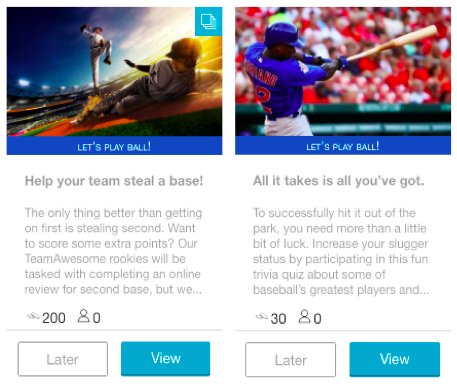
Everyone is very familiar with being in a classroom, so when we did our Master Class we built an educational campaign with a pop culture twist reminiscent of Harry Potter.
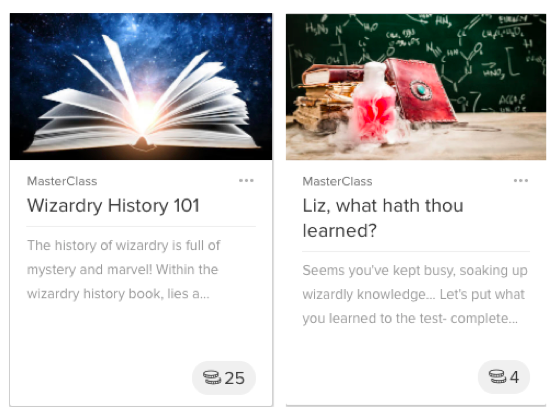
Also, look at your calendar in terms of holidays or popular events (like the Superbowl, for instance). This is a Winter Forest holiday season campaign.

Building block #6: Storyline
A compelling storyline is the key to keeping your advocates hooked and looking forward to the next challenge.
Your advocates should always be the character at the centre of your storyline. Think about who they are and what their motivation is, both intrinsic and extrinsic. Then, think through the journey you want to take them on. (This is a simplified elements of a storyline path.)
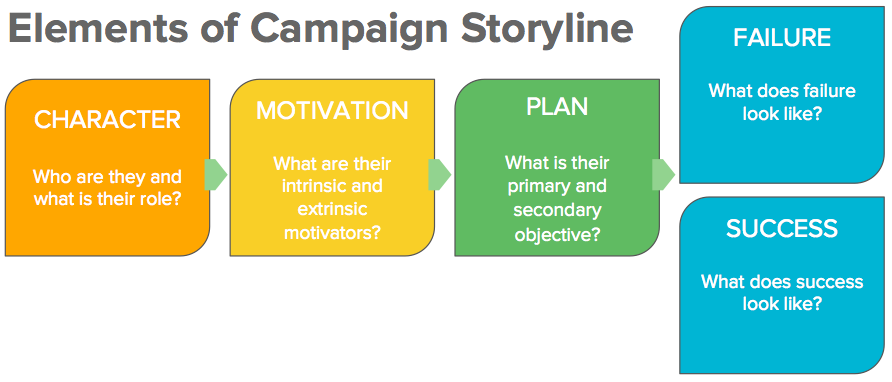
Make sure that your storyline is clear and simple from the start of your campaign. The clearer the story, the more powerful it will be. An overview of your story should all fit within one or two challenges. Your advocates shouldn’t have to be searching through the campaign to figure out what they are supposed to do and how they are going to succeed. Your introductory challenge should include:
- Who the user is within the campaign
- What their motivation is
- What success or failure looks like within the storyline
For example, this opening challenge in our Awaken The Force campaign says “For too long you’ve lingered in the background. Unaware and unable to claim your unique identity, in this campaign we seek to change that. Follow us through six major missions as we develop your skills, document your lineage, and discover who you really are.” Then we outline what they’ll get when they complete each mission.
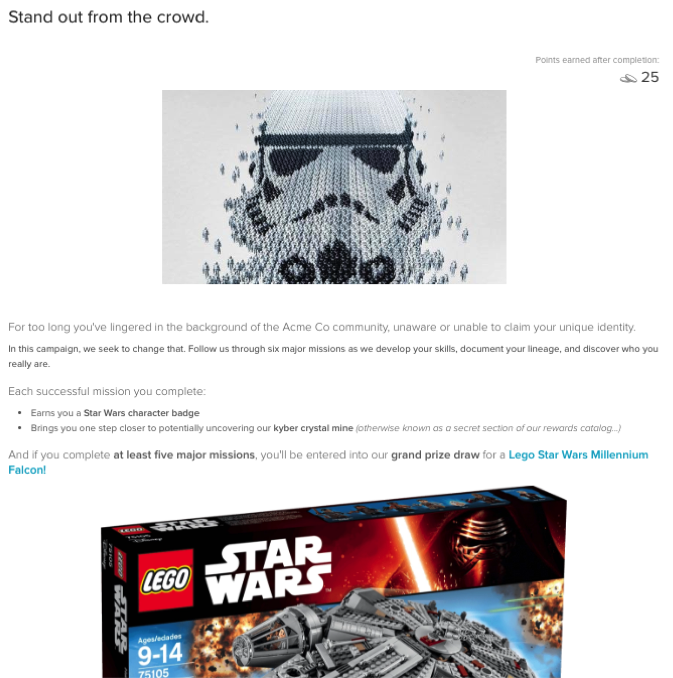
One final note: the advocate is always the hero of the story. This helps make it about them—not what they’re going to do for you. If you are part of that story, you are simply the guide on the sidelines.
Building block #7: Gameplay
Gameplay is important because it increases engagement by making the campaign exciting and sticky.
By wrapping your advocacy requests in a theme, a story and gameplay, you’ll create something that resonates, entertains, and motivates your advocates. Gamification resonates with all of us and will push your advocates in the right direction.
There are three gameplay options that we commonly use: sequential, branched, and open play.
1. Open play. This is again another example from our Winter Wonderland Campaign. Advocates can come in and they can see different groupings of challenges. However, we are not telling them which group of challenges to complete first. They have what we call open play. They are allowed to choose how they play the game. As they complete all of the challenges in one group, they unlock a secret elf shop where they can decide to enter a raffle for a reward. However, they are not required to follow any specific path or order. They can decide the path that they want to take.
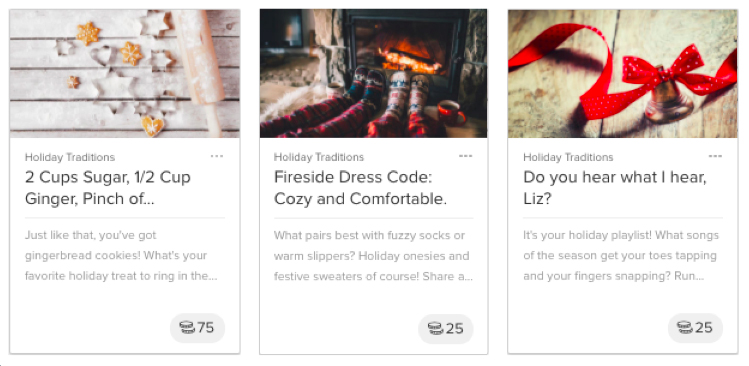
2. Sequential. Sequential is where the gameplay is a linear experience. This is an example from our X-Files Campaign. When you come into this campaign and complete Case One, you are then able to unlock Case Two, and then Case Three. So, you are following a linear gameplay structure. And typically that can mean we will start with easier cases or easier asks if you’re thinking about it in terms of metrics or targets, and it will increase in complexity as you move forward.
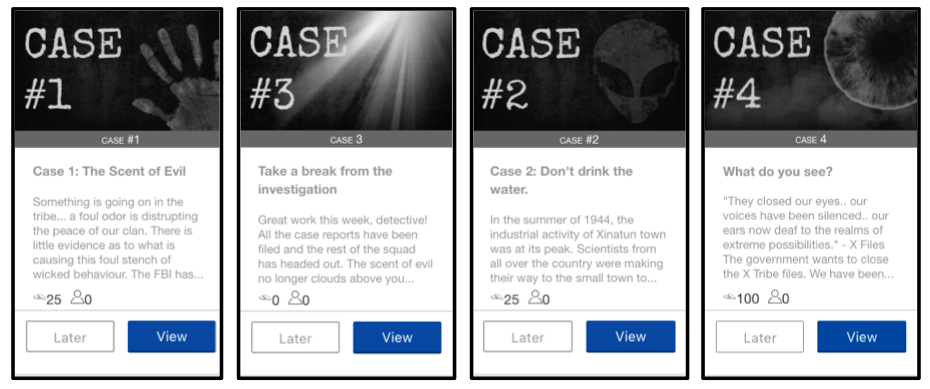
3. Branch gameplay. This style of gameplays tailors the challenges an advocate sees based off certain activities or decisions they make within the game. It’s the most advanced method of gameplay. It gives the advocates a feeling of getting to choose or alter their journey. This type of campaign has variables based on what the player decides to do—which makes it more fun and engaging. It’s a great way to get people invested in playing your campaign.
Our Awaken The Force Campaign is a great example of this. We give advocates the choice to be on the light side or the dark side. Once the advocate has chosen their side, they then see a different path. Everyone who chose the light side would see the path along the top and everyone who chose the dark side would see the path along the bottom. Even the imagery is themed to be light versus dark, depending on their choice. Your leaders are different. Your team is different. Your strengths and weaknesses are different.
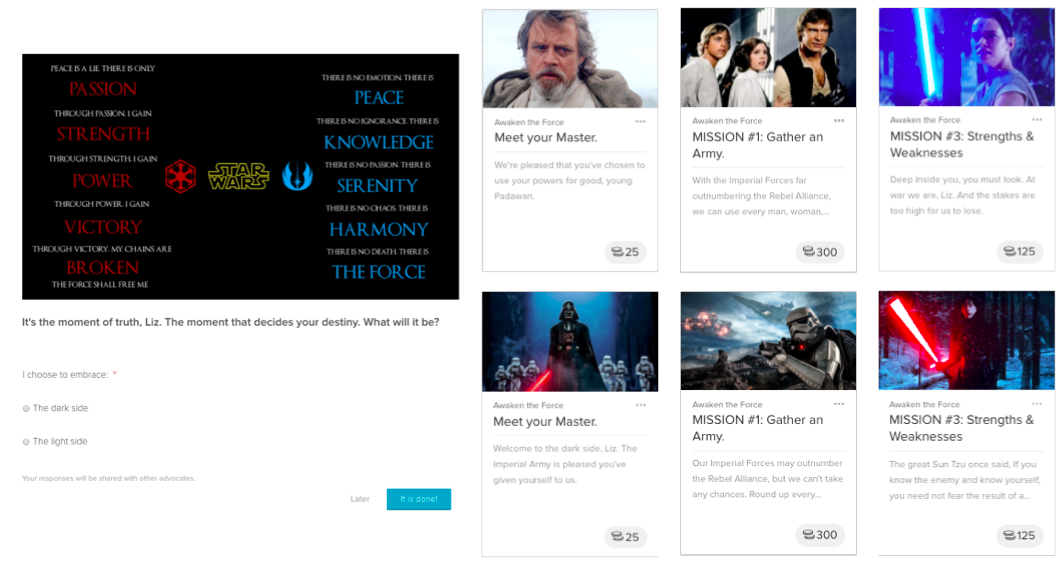
Putting it all together
When you combine these seven elements in creative ways that serve your unique advocates, you’ll be well on your way to succeeding and hitting your metrics.
Hopefully, as you build out your own campaigns, you’ll find them fun to create. And, hopefully, your advocates will find them engaging and entertaining to participate in!








